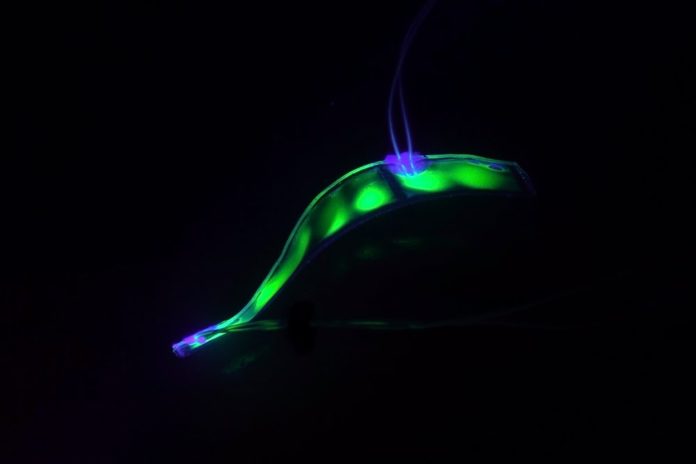Translucent Robotic Eel Dips Underwater Silently Observing Marine Life
Dielectric elastomer actuators (DEAs) are a promising enabling technology for a wide range of emerging applications, including robotics, artificial muscles, and microfluidics. And now, a new study by researchers at the UC San Diego suggests a potential for DEAs with fluid electrodes to serve as artificial muscles for quiet, translucent, swimming soft robots for applications including surveillance and the unobtrusive study of marine life.
An innovative, eel-like robot developed by engineers and marine biologists at the University of California can swim silently in salt water without an electric motor. Instead, the robot uses artificial muscles filled with water to propel itself. The foot-long robot, which is connected to an electronics board that remains on the surface, is also virtually transparent.

“Instead of propellers, our robot uses soft artificial muscles to move like an eel underwater without making any sound,” said Caleb Christianson, a Ph.D. student at the Jacobs School of Engineering at UC San Diego.
“Our biggest breakthrough was the idea of using the environment as part of our design
,” said Michael T. Tolley, the paper’s corresponding author and a professor of mechanical engineering at the Jacobs School at UC San Diego. “There will be more steps to creating an efficient, practical, untethered eel robot, but at this point we have proven that it is possible.”Previously, other research groups had developed robots with similar technology. But to power these robots, engineers were using materials that need to be held in constant tension inside semi-rigid frames. The Science Robotics study shows that the frames are not necessary.
“This is in a way the softest robot to be developed for underwater exploration,” Tolley said.
While the technology is preliminary, Michael Mayer, a professor of biophysics at the Adolphe Merkle Institute of the University of Fribourg in Switzerland and the corresponding author on a paper about the device, believes it may one day be useful for powering implantable or wearable devices without the toxicity, bulk or frequent recharging that come with batteries. Further down the road, it could even lead to bioelectric systems that could generate electricity from naturally occurring processes inside the body.
The team’s pride and glory was tested inside a saltwater tank filled with jellyfish, coral and bony fish at the Birch Aquarium at the Scripps Institute of Oceanography at UC San Diego.
Going forward, researchers plan to improve the the robot’s geometry and reliability with the ultimate goal of building a head for the bot that would carry more sensors.






























